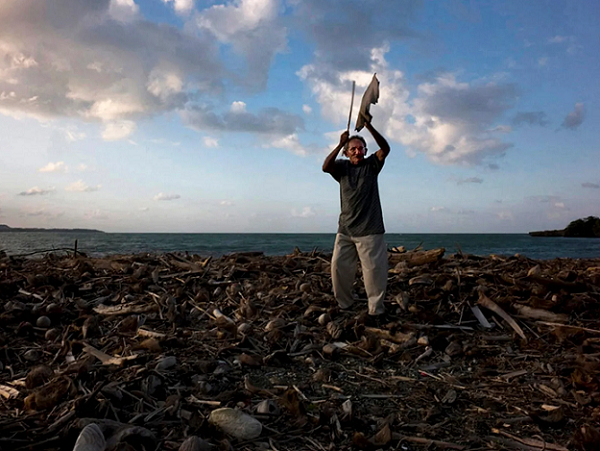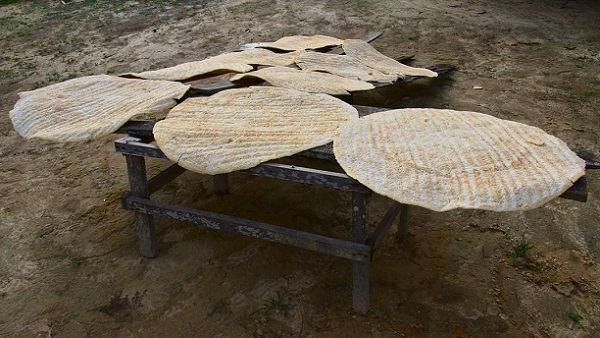[Many thanks to Michael O’Neal (Slavery, Smallholding and Tourism) for bringing this item to our attention.] “The Native people of Hispaniola were long believed to have died out. But a journalist’s search for their descendants turned up surprising results.” In this fascinating article, Robert M. Poole (contributing editor, Smithsonian Magazine) explores the vestiges of Taíno peoples and culture in the Caribbean.
If you have ever paddled a canoe, napped in a hammock, savored a barbecue, smoked tobacco or tracked a hurricane across Cuba, you have paid tribute to the Taíno, the Native people who invented those words long before Christopher Columbus arrived in the New World in 1492.
Their world, which had its origins among the Arawak tribes of the Orinoco Delta, gradually spread from Venezuela across the Antilles in waves of voyaging and settlement begun around 400 B.C. Mingling with people already established in the Caribbean, they developed self-sufficient communities on the island of Hispaniola, in what is now Haiti and the Dominican Republic; in Jamaica and eastern Cuba; in Puerto Rico, the Virgin Islands and the Bahamas. They cultivated yuca, sweet potatoes, maize, beans and other crops as their culture flourished, reaching its peak by the time of European contact.
Some scholars estimate the Taíno population may have reached more than three million on Hispaniola alone as the 15th century drew to a close, with smaller settlements elsewhere in the Caribbean. Whatever the number, the Taíno towns described by Spanish chroniclers were densely settled, well organized and widely dispersed. The Natives were inventive people who learned to strain cyanide from life-giving yuca, developed pepper gas for warfare, devised an extensive pharmacopeia from nature, built oceangoing canoes large enough for more than 100 paddlers and played games with a ball made of rubber, which fascinated Europeans seeing the material for the first time. Although the Taíno never developed a written language, they made exquisite pottery, wove intricate belts from dyed cotton and carved enigmatic images from wood, stone, shell and bone. [. . .]
In short order, Columbus established the first American colony at La Isabela, on the north coast of Hispaniola, in 1494. After a brief period of coexistence, relations between the newcomers and natives deteriorated. Spaniards removed men from villages to work in gold mines and colonial plantations. This kept the Taíno from planting the crops that had fed them for centuries. They began to starve; many thousands fell prey to smallpox, measles and other European diseases for which they had no immunity; some committed suicide to avoid subjugation; hundreds fell in fighting with the Spaniards, while untold numbers fled to remote regions beyond colonial control. In time, many conquistadors married Taíno women, combining the genes of the New World and Old World to create a new mestizo, or mixed, population, which took on Creole characteristics with the arrival of African slaves in the 16th century. By 1514, barely two decades after first contact, an official survey showed that 40 percent of Spanish men had taken Indigenous wives. The unofficial number is undoubtedly higher.
“Very few Indians were left after 50 years,” said Ricardo Alegría, a Puerto Rican historian and anthropologist I interviewed before his death this past July. He had combed through Spanish archives to track the eclipse of the Taíno. “Their culture was interrupted by disease, marriage with Spanish and Africans, and so forth, but the main reason the Indians were exterminated as a group was sickness,” he told me. He ran through the figures from his native island: “By 1519, a third of the aboriginal population had died because of smallpox. You find documents very soon after that, in the 1530s, in which the question came from Spain to the governor. ‘How many Indians are there? Who are the chiefs?’ The answer was none. They are gone.” Alegría paused before adding: “Some remained probably … but it was not that many.”
Possibly as many as three million souls—some 85 percent of the Taíno population—had vanished by the early 1500s, according to a controversial extrapolation from Spanish records. As the Native population faded, so did Taíno as a living language. The Natives’ reliance on beneficent icons known as cemís gave way to Christianity, as did their hallucinogen-induced cohoba ceremonies, which were thought to put shamans in touch with the spirit world. Their regional chieftaincies, each headed by a leader known as a cacique, crumbled away. Their well-maintained ball courts reverted to bush.
Given the dramatic collapse of the indigenous society, and the emergence of a population blending Spanish, Indigenous and African attributes, one might be tempted to declare the Taíno extinct. Yet five centuries after the Natives’ fateful meeting with Columbus, elements of their culture endure—in the genetic heritage of modern Antilleans, in the persistence of Taíno words and in isolated communities where people carry on traditional methods of architecture, farming, fishing and healing.
For more than a year, I searched for these glimpses of Taíno survival, among living descendants in New York City and dusty Caribbean villages, in museums displaying fantastic religious objects created by long-dead artists, in interviews with researchers who still debate the fate of the Taíno.
My search began in the nooks and crannies of limestone caves underlying the Dominican Republic, where the Taíno believed their world began. “Hispaniola is the heart of Taíno culture and the caves are the heart of the Taíno,” said Domingo Abréu Collado, chief of the speleology division in the Dominican Ministry of Environmental and Natural Resources. He clapped on a hard hat at the entrance to the Pomier Caves, a complex of 55 caverns less than an hour’s drive from the gridlock of Santo Domingo. He led me from the eye-numbing brilliance of tropical noon into a shadowy tunnel, where our headlamps picked out the image of a face carved into stone, its eyes wide in surprise. “That’s Mácocael,” said Abréu. “This guy was supposed to guard the entrance of the cave at night, but he got curious and left his post for a look around outside. The sun caught him there and turned him to stone.” The sentinel, whose Taíno name means “No Eyelids,” now stands guard for eternity.
[. . .] Abréu’s headlamp fell upon images of stick figures who seemed to be smoking pipes; others bent over bowls to inhale snuff through long tubes. These were the tribal leaders who fasted until their ribs showed, cleansed themselves with vomiting sticks and snorted cohoba powder, a hallucinogen ground from the seeds of the Anadenanthera peregrina, a tree native to the Caribbean.
The cohoba ritual was first described by Friar Ramón Pané, a Hieronymite brother who, on the orders of Columbus himself, lived among the Taíno and chronicled their rich belief system. Pané’s writings—the most direct source we have on ancient Taíno culture—was the basis for Peter Martyr’s 1516 account of cohoba rites: “The intoxicating herb,” Martyr wrote, “is so strong that those who take it lose consciousness; when the stupefying action begins to wane, the arms and legs become loose and the head droops.” Under its influence, users “suddenly begin to rave, and at once they say … that the house is moving, turning things upside down, and that men are walking backwards.” Such visions guided leaders in planning war, judging tribal disputes, predicting the agricultural yield and other matters of importance. And the drug seems to have influenced the otherworldly art in Pomier and other caves.
[. . .] The first signs began to appear around the town of Bayaguana, where the road narrowed and we jounced past plots of yuca, plantains and maize, some of which were planted in the heaped-earth pattern favored by Taíno farmers of old. New fields, cleared by the slash-and-burn methods Natives brought here from South America, smoldered along the way. On the fringes of Los Haitises National Park, we met a woman who had set up shop beside the road to sell casabe, the coarse, flat Taíno bread made from yuca. “None left,” she said. “I sold the last of it yesterday.” We began to see simple, sensibly designed houses with thin walls of palm planks and airy roofs of thatch, like those depicted in Spanish woodcuts from Columbus’ day. [. . .]
Relegated to a footnote of history for 500 years, the Taíno came roaring back as front-page news in 2003, when Juan C. Martínez Cruzado, a biologist at the University of Puerto Rico, announced the results of an island-wide genetic study. Taking samples from 800 randomly selected subjects, Martínez reported that 61.1 percent of those surveyed had mitochondrial DNA of indigenous origin, indicating a persistence in the maternal line that surprised him and his fellow scientists. The same study revealed African markers in 26.4 percent of the population and 12.5 percent for those of European descent. The results encouraged a Taíno resurgence, with native groups urging Puerto Rican schools to take note of the indigenous contribution to Caribbean history, opposing construction on tribal sites and seeking federal recognition for the Taíno, with attendant benefits. [. . .]
Like Kukuya, thousands of Puerto Ricans have been discovering their inner Taíno in recent years. In the 2010 census, for example, 19,839 Puerto Ricans checked the identity box marked “American Indian or Alaskan Native,” an increase of almost 49 percent over the 2000 count, when 13,336 checked it. Neither canvass provided a Taíno option. The native population represents less than 1 percent of Puerto Rico’s 3.7 million people, but indigenous leaders consider the latest head count a milestone—further proof that some Natives live on long after they were thought to be annihilated. [. . .]
A few pockets of Taíno culture remain in eastern Cuba, an area shaped by rugged mountains and years of isolation. “Anybody who talks about the extinction of the Taíno has not really looked at the record,” said Alejandro Hartmann Matos, the city historian of Baracoa, Cuba’s oldest city, and an authority on the island’s earliest inhabitants. Hartmann, a Cuban of German ancestry, had invited me to meet Indigenous descendants from the island’s Oriente region, as well as to mark the 500th anniversary of Baracoa, founded in 1511. Joining us was José Barreiro, assistant director of research at the Smithsonian’s National Museum of the American Indian. With Hartmann, Barreiro has been tracking Indigenous descendants since 1989. Based on their research, the pair estimate that at least 5,000 Natives survive in Cuba, while hundreds of thousands likely have indigenous roots. [. . .]
For full article, see https://www.smithsonianmag.com/history/who-were-taino-original-inhabitants-columbus-island-73824867/?
[Photo above by Maggie Steber: “Taíno cacique Francisco Ramírez Rojas beats a palm frond to drive away bad spirits at a seaside ceremony of thanksgiving. A three-sided idol known as La Muñequina is thought to represent the Taíno belief that spirits of the dead are present among the living.” Next photo, “Casabe is a bread made from yuca,” Wikimedia Commons.]


